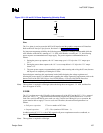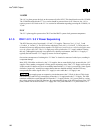
Intel
®
820E Chipset
R
188 Design Guide
1.8 VSB
The 1.8 V
SB
plane powers the logic to the resume well of the ICH2. This should not be used for VCMOS.
The VCMOS described in the 2.5 V
SBY
section should be powered down in S5. However, the 1.8 V
SB
requires power in S5. Refer to the 2.5 V
SBY
section for information regarding powering the VCMOS (1.8
V) rail.
2.5 V
The 2.5 V plane supplies power to the CK133 and the DRCG system clock generator components.
6.1.3. ICH2 1.8 V / 3.3 V Power Sequencing
The ICH2 has two pairs of associated 1.8 V and 3.3 V supplies. These are (Vcc1_8, Vcc3_3) and
({VccSus1_8, VccSus3_3). The ICH2-m has a third pair (VccLAN1_8, VccLAN3_3). These pairs are
assumed to power up and power down together.
The difference between the two associated supplies must
never be greater than 2.0 V.
The 1.8 V supply may come up before the 3.3 V supply without violating
this rule. (Although this generally is not practical in a desktop environment, since the 1.8 V supply is
typically derived from the 3.3 V supply by means of a linear regulator.)
One serious consequence of violating this “2 V Rule” is electrical overstress of oxide layers, resulting in
component damage.
Most ICH2 I/O buffers are driven by the 3.3 V supplies, but are controlled by logic powered by the 1.8 V
supplies. Thus, another consequence of faulty power sequencing arises if the 3.3 V supply comes up first.
In this case the I/O buffers will be in an undefined state until the 1.8 V logic is powered up. Some signals
defined as “input-only” actually have output buffers that are disabled normally, and the ICH2 may
unexpectedly drive these signals if the 3.3 V supply is active while the 1.8 V supply is not.
Figure 103 is an example power-on sequencing circuit that ensures the 2 V Rule is obeyed. This circuit
uses a NPN (Q2) and PNP (Q1) transistor to ensure the 1.8 V supply tracks the 3.3 V supply. The NPN
transistor controls the current through PNP from the 3.3 V supply into the 1.8 V power plane by varying
the voltage at the base of the PNP transistor. By connecting the emitter of the NPN transistor to the 1.8 V
plane, current will not flow from the 3.3 V supply into 1.8 V plane when the 1.8 V plane reaches 1.8 V.


















